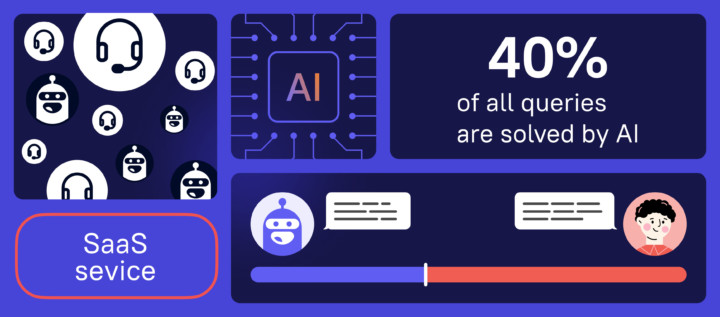Customer Service: why you need it and how to level it up

The purpose of any business is sales and profit, and the profit is brought by customers. Happy customers bring more profit and growth to the business. Therefore, businesses must take care of their happiness.
What is Customer Service?
Customer Service is the support you provide to your users before and after purchase. Support goes far beyond the call center agents’ capabilities. It’s available via email, website or application chat, messengers, and social media. Often the support works round the clock; a user can ask a question at any time and in any way they like, and they will get an answer.
But Customer Service doesn’t just mean answering user questions. It is an important part of brand interaction with the audience.
Why is it important?
The quality of support plays a crucial role in whether or not the user will choose your product.
Customer happiness is important to the company because customers pay money. Poor clients will not pay money and will leave to pay the company that will make them happy.
Irene Allen
Customer support team lead
In the past, people made purchase decisions mainly based on the price of the product, but now their decisions are based on the overall impression of the company.
According to the data of Gartner Research, 89% of companies are now competing by exactly the quality of support.
Quality support is an important part of successful customer experience, especially when your Customer Service goes beyond answering questions. If your agents are ahead of the curve or if they have an internal service to upsell and cross-sell relevant products, you will surely win the hearts and seriously outpace your competitors.
Customer Service has a tangible impact on profits
That’s where we started, and now we’re gonna talk more about it. You’ve probably heard that it’s much cheaper to retain existing customers than to acquire new ones (according to some estimates, the acquisition costs 6-7 times more).
Poor support is one of the main reasons for customer churn. U.S. Small Business Administration analysts have estimated that 68% of users leave because they have encountered a negative experience contacting support.
Poor support will kill your reputation
Customers are used to getting what they want instantly and overall, their standards have been raised. In addition, they immediately write negative reviews on the Internet, which have a wide reach and can ruin your reputation.
It’s important to support customers equally well in all channels as any error can become fatal.
Customer Service is a part of the interaction with the product
The boundaries between the product and service are erased, and customer support has become a part of it. You can find an online chat on almost any website you go to. Many websites embed links to the knowledge base into the product information. And with seamless chat integration for apps from Sendbird, it’s even possible for customers to have conversations with support agents without needing to leave a standalone piece of mobile software. Thus the expectations of typical consumers are set higher because the b
By paying for your service or product, the customer already counts on the support and considers it a part of their purchase.
Customers are willing to pay more for the quality support
Focusing on a positive customer experience is not just a fashion trend. Every contact you have with a user not only encourages them to love you more but also increases your income. According to the research conducted by SalesForce, 86% of customers are ready to pay more if you provide quality support to them. You may even think about a new premium plan with extended support, as many users will probably be interested.
How to level Customer Service up?
Make customer happiness the company’s primary goal
It seems that customer happiness is the concern of the support team. What do a designer, an accountant, a developer have to do about it?
Support agents are part of the team that deals with customers directly. Their work will be much easier if the whole company is focused on its customers when making important decisions.
Read also:
⭐ 17 Zendesk alternative services and 13 live chat alternatives to try this year
⭐ 2025 Email Sales Funnel: How to Maximize Conversions with 11 Proven Examples
⭐ The Leaky Funnel: 6 Powerful Strategies to Stop Losing Leads
Besides, this approach will save you from organizational issues. Everyone will speak the same language and information between teams will be transmitted quickly.
Let’s say the customer is not happy with the delivery of your product; the product was damaged during delivery. If all teams are working asynchronously, the number of dissatisfied customers will increase: those who are engaged in packaging will continue to do their job poorly because they are not responsible for the end result which is customer happiness.
If you set customer happiness as the overall goal, there will be fewer difficulties like these.
Continuously educate support agents
Allocate time and budget for training your support team. It is important that each agent has a clear understanding of how to meet customer needs.
According to research conducted by MIT Sloan, users really take support quality to heart:
- 92% of customers want to be treated respectfully;
- 76% of customers expect the issue not to happen again;
- 74% of customers wait for an explanation of why the issue happened;
- 63% of customers want to give a piece of their minds;
- 62% of customers wait for apologies.
Define the customer journey
Analyze your interaction with the customer. To do so, answer the following questions:
- How soon after the purchase does the customer contact you?
- How often do customers text (or call) support?
- What channels do they use for this?
- What do they ask most often?
- Have customers who eventually stop buying from you contacted you more or less often than those who stay with you?
- How do you evaluate customer engagement?
Answers to these questions will help you visualize your customer’s journey:

Understanding the journey will allow you to:
- see the context of inquiries that come into support (at what stage of acquaintance a user is, how loyal they are, how often they use the product);
- finetune the product according to the most frequent inquiries;
- predict inquiries and allocate team strengths accordingly;
- decrease churn and increase LTV.
In other words, you can forestall user inquiries.
At every stage of the customer journey, there is a risk of a customer experiencing issues and falling into the churn. Timely and quality support will help them cope with difficult situations and stay in the product.
Irene Allen
Customer support team lead
For example, if your customer journey is similar to the one we have shown above, in the first month of work, a user has questions about billing, that is, how the bill is issued and how to pay it. You can solve this issue if you offer relevant information immediately after registration.
Read also:
15 best lead generation services to grow your base in 2023
The 36 statistics on how chatbot for businesses grow your revenue in 2023
The secret weapon of your competitors or Why you should focus on customer service first
Make support omnichannel
Some users find it more convenient to call and discuss all the questions over the phone. Others would prefer to describe their issue in detail in an email and wait for a detailed answer. Others will wait for an immediate answer in a messenger.
It is important to provide support in all channels that your customers use, and making the support omnichannel is just a cherry on the cake. In this case, the customer who contacted you in a chat can clarify the answer by phone or ask for a report by email. And in any channel, their inquiry will be understood and executed.
Set the Customer Service goals
What you need to set SMART goals for the support team:
- define specific and measurable goals for each specific area (not “make customers happier by 15%”, but “reduce the number of new inquiries by 15%”);
- let the goals be difficult enough for you to keep growing, but they should be achievable;
- make sure the support goals are directly related to the goals of the entire company;
- determine how often you will measure progress.
Effective Customer Service objectives can be focused on user retention, increasing LTV, and overall satisfaction growth.
For example:
- Reduce the average inquiry processing time from 20 to 10 minutes;
- raise NPS to 15% by next year;
- increase the satisfaction index by 5% over 3 months.
Track key performance indicators
Once you have set the goals, you need to define the KPIs by which you will track progress in achieving them.
These indicators help instantly assess how well your support team is performing.
Support directly affects SLA metrics (such as first response speed, dialog closure speed, etc.) and user loyalty, but common product metrics such as MRR, LTV, NPS, user churn, and conversion to using the product also depend on it.
Irene Allen
Customer support team lead
The following indicators can be used to determine the effectiveness of support:
- Customer Satisfaction Score (CSAT);
- Net Promoter Score;
- First response speed;
- Average inquiry resolution time;
- The number of active inquiries;
- The number of resolved inquiries;
- Customer Retention Rate.
It is important to analyze these indicators in conjunction with each other. For example, your team may successfully reduce the time it takes to resolve an issue, but the quality will suffer and customer satisfaction will decrease. Select the metrics you want to monitor, establish relationships between them and gradually move towards the goals.
Read also: 10 conversion rate optimization tools to enhance your funnel and boost revenue
Choose the right instruments
Ensure that agents are equipped with all the necessary software to quickly find the right information, make quick decisions, and coordinate multiple channels and dialogs at the same time.
Users want to be heard, cared for, and understood, and there is no room for mistakes. A handy platform will allow your agents to react quickly and not go crazy.
If your customer data is not centralized, you will encounter problems every time one of the agents goes on sick leave or vacation. Another important point is that the data must be available and understandable. Keeping strictly personal notes is not a good idea, because another person may get confused in your notes.
Give authority to your agents
Well, if you have completed all the previous steps, you have a good Customer Service strategy. To make it great, there is only one step left — to broaden the powers of the support agents.
Thus, not only will they be able to process inquiries faster, but they will also be able to do it better. The secret is that each team member can make their own decisions without navigating through the maze of approvals.
Identify the measures that the agent can take to resolve the issue. For example:
- offer a discount to make up for the inconvenience;
- arrange product replacement or return;
- prepare and present bonuses and special offers to customers.
There is an interesting policy in the Ritz-Carlton hotel chain: employees can spend $2,000 to solve a customer issue. The manager does not have to wait for approval; they can take any measure that fits this budget.
Why exactly $2,000? Because each customer’s LTV is $250,000!
Read also: Customer engagement strategy template to create omnichannel campaigns
What’s the result?

There is no ideal solution when it comes to Customer Service. But there are right ways to make your customers feel that you care for them. To do this, don’t forget to:
- get all teams focused on customer happiness;
- plan the customer’s full journey and prepare for the most common challenges encountered along the way;
- set goals and KPIs for the support team;
- equip your team with the convenient internal environment;
- gather reviews and make adjustments based on them.
This way, your customers will not be a hindrance to your work, but the brand support and advocates.
In addition, customers can be a source of ideas for the company’s growth; the support team works closely with customers and knows best what their issues are and what changes in the product can improve their user experience.
The reactive part of the support team’s work is to respond to incoming inquiries and solve users’ issues, but the support team has many capabilities and competences to proactively influence the service as a whole.
Irene Allen
Customer support team lead
Read also:
👉 Live Chat Best Practices: 20 Hacks to Make Customer Service Better
👉7 Best Live Chat for eCommerce: Boost Conversion on your Website
👉 Top 5 live chat mobile app: find the best fit for your business
👉 Live Chat: How Online Chat Tool Can Help Your Business
👉 20 Best Live Chat Software for your website chat service







